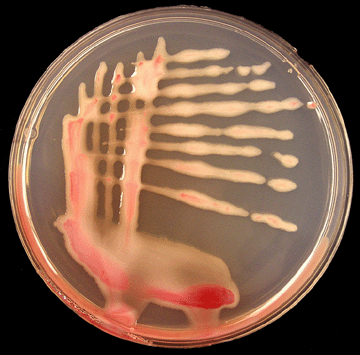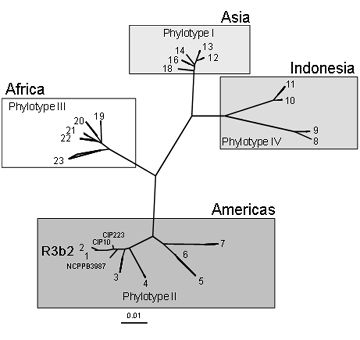| Ralstonia solanacearum Race 3 Biovar 2 Descalgar la guía descriptiva al formato PDF |
|||
| Roll your mouse over the red-colored words to see word definitions. This will open Pop-up windows. If not, print the glossary |
|||
| Printer friendly |
PDF file |
Glossary |
|
| Symptoms & signs | Causal organism | Disease cycle & epidemiology | Detection & identification | Management | References |
| Causal organism |
Ralstonia solanacearum (Smith 1896) Yabuuchi et al. 1996, is a
Bacteria have been classified as Gram-negative or Gram-positive regarding structural differences in their cell walls. Many species of Gram-negative bacteria are pathogenic. This pathogenic capability is usually associated with certain components of Gram-negative cell wallsGram-negative , rod-shaped, strictly
An aerobic organism requires oxygen for aerobic cellular respiration. Cellular respiration is the mechanism by which aerobic organism require oxygen to utilize substrates (for example sugars and fats) in order to obtain energyaerobic bacterium that is 0.5-0.7 x 1.5-2.0 µm in size. It is very sensitive to desiccation and is inhibited in culture by low concentrations (2%) of sodium chloride (NaCl). For most strains, the optimal growth temperature is
28-32ºC82-90ºF; however some strains that are pathogenic on potato have a lower optimal growth temperature of
27ºC80.5ºF.
Liquid and solid (agar) growth media are commonly used for culture of the bacterium. On solid agar medium, individual
On the surface of a solid growth medium, individual bacterial cells will grow and multiply to become visible bacterial colonies. All cells within the colony descend from a single ancestor and are identical. Characteristics of bacterial colonies (color, aspect, diameter or growth rate) are commonly used for bacteria identificationbacterial colonies are usually visible after 36 to 48 hours of growth at
28ºC82.4ºF, and two main colony types differing in morphology can be distinguished: colonies of the normal or
Virulence refers to the degree of pathogenicity of a microorganism, or in other words the relative ability of a microorganism to cause diseasevirulent type that are white or cream-colored, irregularly-round, fluidal, and opaque; and colonies of the mutant or non-virulent type that are uniformly round, smaller, and butyrous (dry) (Photo 13).
This shift from virulent to non-virulent bacterial cells occurs during storage or under oxygen stress in liquid media. A tetrazolium chloride (TZC) medium was developed to differentiate between the two colony types, in which virulent colonies appear white with pink centers and non-virulent colonies appear dark red (Photo 14). A semi-A growth or culture medium is a substance in which microorganisms, such as bacteria, or cells can grow. Selective media are used for the growth of only select microorganisms. They usually contain antibiotics to which the select microorganims is resistant to selective medium, called modified SMSA medium, has been developed for detection of R. solanacearum in water and soil samples, and in plant extracts. On this medium, typical bacterial colonies appear fluidal, irregular in shape, and white with pink centers after 2 to 5 days incubation at 82.4ºF (see the detection and identification section).
 |
 |
|
| Photo 8. Virulent (bottom) and non-virulent (top) colonies of R. solanacearum on CPG agar growth medium (Photo courtesy of P. Champoiseau, University of Florida) |
Photo 9. Virulent colonies of R. solanacearum on TZC agar medium (Photo courtsey of P. Champoiseau, University of Florida) |
|
For long term storage, R. solanacearum can be stored for several years at room temperature in sterilized tap, distilled or deionized water.
Many
A strain is a genetic variant or subtype of a microorganism (for example virus or bacterium or fungus)strains of R. solanacearum have been identified and characterized worldwide, revealing significant
here refers to variation of a given characteristic from one bacterial strain (or group of strains) to the othervariability within the A species is one of the basic units of biological classification. A species is often defined as a group of organisms capable of interbreeding and producing fertile offspring. Each species is placed within a single genusspecies. R. solanacearum is therefore considered a “
R. solanacearum is considered a "species complex" as it includes individual isolates that may not be considered within a single species, as it is the case for the banana blood disease bacterium or Pseudomonas syzygiispecies complex”. Based on variability in host range and in ability to utilize several
Carbohydrates are simple organic compounds such as sugars and starch which contain carbon chains. They fill numerous roles in living organisms, such as the storage and transport of energy and structural components. Carbohydrates are differentially used as source of energy by bacteriacarbohydrate substrates, R. solanacearum was initially subdivided into
A race is formed by a group of bacterial strains that are differentiated based on the response on a set of host differentialsraces and
A biovar is a group of bacterial strains that are distinguishable from other strains of the same species on the basis of their physiological characteristicsbiovars. So far, five races and five biovars have been identified within the species (Table 1), but this old classification system is unsatisfactory because it is not predictive and some groups (e.g. race 1) contain very large variation.
| Table 1. Characteristics of races and their relationship to biovars of R. solanacearum (from Denny and Hayward, 2001; Daughtrey, 2003). | |||
| Race | Primary hosts | Geographical distribution | Biovar |
| 1 2 3 4 5 |
Wide (tobacco, tomato, solanaceous and nonsolanaceous weeds, diploid bananas, groundnut, potato, pepper, eggplant, olive, ginger, strawberry, geranium, Eucalyptus, other plants…) Triploid bananas, other Musa spp. Potato and tomato Ginger Unknown Mulberry tree |
Asia, Australia, Americas Caribbean, Brazil, Philippines Worldwide except US and Canada Australia, China, Hawaii, India, Japan, Mauritius, South Asia India China |
3, 4, 1 1 2 (or 2A)* 4, 3 5 |
| * Typical race 3 strains are sometimes referred to as biovar 2A. New race 3 strains from the Amazon basin have been placed in a new biovar, designed as 2T or N2 (their relation to races is unclear). | |||
Recently, a new classification scheme has been described for strains of R. solanacearum, based on Comparison of DNA sequences is commonly used for classification studies of strains of microorganisms. It is basically assumed that the higher the homology is between two strains, the more closely related the strains are in terms of evolution. These type of studies are known as phylogenetic studiesvariation of DNA sequences. Twenty-three A sequevar, or sequence variant, is defined as a group of strains with a highly conserved sequence within the area sequencedsequevars and four A phylotype is defined as a group of strains that are closely related based on phylogenetic analysis of sequence data. Each phylotype is composed of a number of sequevarsphylotypes were identified within the species that broadly reflects the ancestral relationships and geographical origins of the strains (Figure 1). |
 |
Figure 1. Classification and geographic origins of R. solanacearum strains based on sequence analysis of
Endoglucanase is a type of cellulase which is a class of enzymes produced by fungi, bacteria, and protozoans that catalyze the cellulolysis (or hydrolysis) of celluloseendoglucanase gene sequences. |
Ralstonia solanacearum race 3 biovar 2 strains belong to phylotype II and sequevars 1 and 2.
Initially described as pathogenic on potato and tomato, R. solanacearum race 3 biovar 2 was shown to also infect and induce symptoms on eggplant, geranium, and pepper. Other solanaceous and non-solanaceous weeds, such as the bittersweet or woody nightshade (Solanum dulcamara) (see the disease cycle and epidemiology section for illustration), are considered as alternate hosts. Most of these alternate hosts remain latently infected and may not show any disease symptoms, but they can be epidemiologically important as inoculum sources and refuges.
Sometimes referred as the ‘cold tolerant’ race, R. solanacearum race 3 biovar 2 originated in the Andes and was probably disseminated worldwide on potato tubers. It is now known to occur in the highlands of the tropics and in subtropical and temperate areas throughout the world, except in North America.
| Symptoms & signs | Causal organism | Disease cycle & epidemiology | Detection & identification | Management | References |
| Author: | Patrice G. Champoiseau of University of Florida |
| Reviewers: | Caitilyn Allen of University of Wisconsin; Jeffrey B. Jones, Carrie Harmon and Timur M. Momol of University of Florida |
| Publication date: | September 12, 2008 |
| Supported by: | The United States Department of Agriculture - National Research Initiative Program (2007-2010) |

